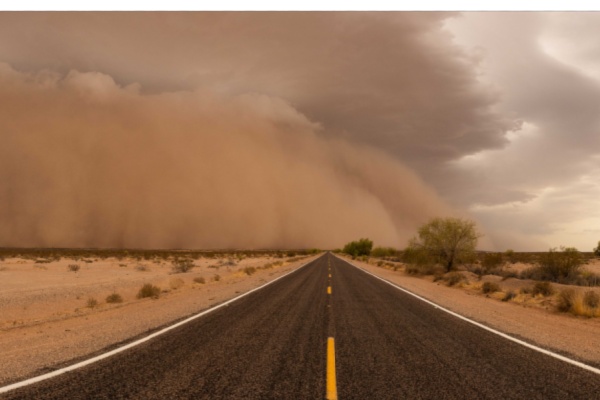A pileup on Interstate 10 in Arizona over the weekend killed four people and injured several others. The accident, which happened near Tonopah – about 50 miles west of Phoenix – involved 12 vehicles including several semi trucks, a van, and a recreational vehicle towing a trailer, the Arizona Department of Public Safety said in a statement.
Then, a fast-moving dust storm shrouded southwestern New Mexico and parts of northern Mexico in darkness Monday morning, prompting an emergency alert for drivers to “shelter in place” as officials tried to get cars off the interstate.
As AccuWeather reports, the dust storm, known meteorologically as a haboob, swept across Deming and Doña Ana counties in New Mexico at a breakneck pace with near-zero visibility and winds of 45 mph, the National Weather Service warned. State officials closed parts of Interstate 10 because of the dangerous travel conditions. The National Weather Service also issued a dust storm warning for parts of Interstates 10 and 25 and US Highway 70.
The haboob grew as it whipped east across the dry, dusty landscape. High wind warnings were in effect Monday in the Southwest alongside low humidity, increasing the threat of wildfire. NOAA weather satellites captured the haboob’s size and movement from space, seen below highlighted in yellow with NOAA’s dust product, which detects dust and sand-sized particles in the air and distinguishes them from clouds.
What Is a Haboob?
A haboob is an extreme type of dust storm that persists for multiple hours. It’s essentially a wall of dust and debris that can grow up to 5,000 feet tall as it’s blown forward by strong winds.
Haboobs are created when a thunderstorm collapses, forcing air down and forward, dragging dust and debris with it. They are more common in the summer following severe thunderstorms.
A haboob is just one of the many ways a day can go from calm to dangerous in a matter of moments. You can see the haboob’s wall of dust coming from a distance but by the time it reaches you, it’s too late to seek shelter — especially if you’re behind the wheel of a vehicle. It’s nearly impossible to see more than a few feet in front of you in the worst of these storms as the dust chokes out light.
What Should You Do if You Get Caught in a Haboob?
Drivers should pull as far off the road as possible when they encounter such a storm, the National Weather Service says. It also recommends engaging the parking or hill brake and turning off all lights — including making sure the driver’s foot is off the brake so the brake light is not illuminated — to avoid confusing any vehicles approaching from behind.
Can You Experience Negative Health Effects from Haboobs?
Haboobs can also bring a significant amount of dust and debris into the air, which can pose a health risk to people with respiratory issues. These dust storms can cause a lung issue known as “haboob lung syndrome” in humans.
Where Are Haboobs Most Likely to Occur?
Haboobs are most common in aris and semi-arid regions, such as the Sahara Desert and the Arabian Peninsula. If you are a fan of the Mission Impossible franchise, in “Ghost Protocol,” there is a scene where Ethan Hunt (Tom Cruise) is chased through a haboob sandstorm in Dubai during a key chase sequence.
Haboobs are also commonly experienced in the southwestern United States and Mexico, especially Arizona, which has a “haboob season.” During “haboob season” these dust storms can occur several times each year. According to NOAA, about 100 haboobs were recorded in Arizona over a ten-year period. Haboobs also commonly occur in New Mexico, Nevada, and Texas. However, Haboobs can also occur in the eastern desert regions of California and even the Columbia Basin in Eastern Washington.
—
Photo Credit: KevinRimcoski / Shutterstock.com
